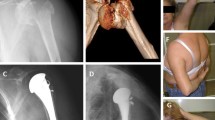Abstract
Introduction
Standard rehabilitation regime following hemiarthroplasty for trauma is early mobilisation to prevent the development of a stiff shoulder. However, an aggressive early rehabilitation may lead to non-union of the greater tuberosity. We hypothesise that a delayed rehabilitation will result in a good union rate without undue risk of shoulder stiffness.
Materials and methods
Between December 1996 and June 2003, 40 patients with three or four part fracture of proximal humerus with or without dislocation, not amenable to open reduction and internal fixation underwent hemiarthroplasty with reconstruction of tuberosities and a conservative rehabilitation regime at our centre (age range of 39–92 with a mean of 68). Pathologic fractures and non-cooperative and/or demented patients were excluded. Patients were kept in a sling for 4 weeks before physiotherapy was commenced. They were reviewed at an average of 55 months (12–95) for assessment of pain, range of movement, activities of daily living and strength. Radiographs were taken to evaluate the union of the greater tuberosity.
Results
One patient lost to follow up. In 12.8% of the patients (mainly elderly, with mean age of 78.8) the greater tuberosity failed to heal. In those with a healed greater tuberosity the average elevation was more than 130°, and the average external rotation was 40°. A total of 51.3% of the patients had excellent results, 33.3% had satisfactory and 15.4% had unsatisfactory results.
Conclusion
Postoperative immobilisation did not result in excessive stiffness and excellent functional results were achieved, especially in those younger than 70 years of age. However, tuberosity union could not be guarantied in very old patients.


Similar content being viewed by others
References
Agorastides I, Sinopidis C, El Meligy M, Yin Q, Brownson P, Frostick SP (2007) Early versus late mobilization after hemiarthroplasty for proximal humeral fractures. J Shoulder Elbow Surg 16(Suppl 3):S33–S38
Boileau P, Caligaris-Cordero B, Payeur F, Tinsi L, Argenson C (1999) Prognostic factors during rehabilitation after shoulder prostheses for fracture. Rev Chir Orthop Reparatrice Appar Mot 85:106–116
Boileau P, Krishnan SG, Tinsi L, Walch G, Coste JS, Mole D (2002) Tuberosity malposition and migration: reasons for poor outcomes after hemiarthroplasty for displaced fractures of the proximal humerus. J Shoulder Elbow Surg 11:401–412
Cofield RH (1984) Total shoulder arthroplasty with the Neer prosthesis. J Bone Joint Surg Am 66:899–906
Constant CR, Murley AH (1987) A clinical method of functional assessment of the shoulder. Clin Orthop 214:160–164
Court-Brown CM, Caesar B (2006) Epidemiology of adult fractures: a review. Injury 37:691–697
Frankle MA, Mighell MA (2004) Techniques and principles of tuberosity fixation for proximal humeral fractures treated with hemiarthroplasty. J Shoulder Elbow Surg 13:239–247
Frich LH, Sojbjerg JO, Sneppen O (1991) Shoulder arthroplasty in complex acute and chronic proximal humeral fractures. Orthopedics 14:949–954
Gerber C, Schneeberger AG, Vinh TS (1990) The arterial vascularization of the humeral head. An anatomical study. J Bone Joint Surg Am 72:1486–1494
Hawkins R, Switlyk P (1993) Acute prosthetic replacement for severe fractures of the proximal humerus. Clin Orthop Relat Res 289:156–160
Hertel R, Hempfing A, Stiehler M, Leunig M (2004) Predictors of humeral head ischemia after intracapsular fracture of the proximal humerus. J Shoulder Elbow Surg 13:427–433
Levine WN, Connor PM, Yamaguchi K, Self EB, Arroyo JS, Pollock RG, Flatow EL, Bigliani LU (1998) Humeral head replacement for proximal humeral fractures. Orthopedics 21:68–73
Neer CS 2nd (1970) Displaced proximal humeral fractures. II. Treatment of three-part and four-part displacement. J Bone Joint Surg Am 52:1090–1103
Robinson CM, Page RS, Hill RM, Sanders DL, Court-Brown CM, Wakefield AE (2003) Primary hemiarthroplasty for treatment of proximal humeral fractures. J Bone Joint Surg Am 85:1215–1223
Wretenberg P, Ekelund A (1997) Acute hemiarthroplasty after proximal humerus fracture in old patients. A retrospective evaluation of 18 patients followed for 2–7 years. Acta Orthop Scand 68:121–123
Zyto K (1998) Non-operative treatment of comminuted fractures of the proximal humerus in elderly patients. Injury 29:349–352
Author information
Authors and Affiliations
Corresponding author
Rights and permissions
About this article
Cite this article
Amirfeyz, R., Sarangi, P. Shoulder hemiarthroplasty for fracture with a conservative rehabilitation regime. Arch Orthop Trauma Surg 128, 985–988 (2008). https://doi.org/10.1007/s00402-008-0646-2
Received:
Published:
Issue Date:
DOI: https://doi.org/10.1007/s00402-008-0646-2



